If your RV or camper’s roof is leaking, damaged, or worn down and old, it might be time to repair or replace the roof.
Over time, rain, wind, snow and even UV rays from the sun can break down the seals and RV roof material, leading to water damage and other issues. You should address RV roof issues as soon as possible, to avoid further damage.
Is your RV roof leaking? Are you stressed out about how much it’s going to cost to fix? If so, you’re not alone.
One of the first questions people have about their leaky motorhome and travel trailer roof is how much it will cost to repair or replace.
Camper roof replacements typically cost between $300 and $325 per linear foot. For example, if your RV is 30 feet long, it would cost between $9,000 and $9,750 to replace the roof of your RV.
The cost largely depends on the type of roof material, and the labor costs of the auto shop completing the job. However, you may be able to repair or replace your RV roof yourself.
In this article, I’ll cover the best types of RV roof material and their costs, as well as provide the steps to re-seal, repair, and replace your camper’s roof. I will also offer some suggestions to keep your RV roof in the best condition.
Type Of RV Roofing Material And How Much Does They Cost To Replace
The most common types of camper roofing material are TPO, EPDM, fiberglass, and aluminum.
In general, EPDM and TPO are the most popular and common types of material used for RV roofs.
Each type of roofing material has different advantages, costs, and maintenance needs. Let’s get into it!
EPDM
Rubber EPDM (Ethylene Propylene Diene Monomer) is a synthetic rubber material with membrane-like construction that is often used for flat roofs like those on RVs and travel trailers.
EPDM is extremely durable and cost-effective, typically costing around $4 to $8 per square foot.
Using our 30-foot RV example, it would cost about $1,020 to $2,040 for 255 square feet of EPDM roofing material for the RV, assuming the camper is 8 ½ feet wide.
TPO
TPO (Thermoplastic Polyolefin) is probably the most common material used for RV roofs.
The material is a single-ply membrane, meaning that it’s a single layer of synthetic rubber with reinforcing scrim. Like EPDM, it’s used primarily for flat roofs.
TPO is very UV-resistant, and it can help reduce energy consumption when installed as your RV roof. Additionally, it’s very long-lasting and if properly maintained, could last as much as 30 years.
Decent quality TPO RV roofing will cost between $5.50 and $6 per square foot, so using our 30-foot camper, the cost for the TPO alone would be between $1,400 and $1,530 for 255 square feet of material.

Fiberglass
Fiberglass is less popular as an RV roofing material because it’s heavier and more expensive than TPO or EPDM.
However, fiberglass roofs require less maintenance than roofs using the other materials, which may be preferable for some.
Fiberglass is one of the toughest roofing materials available, and it is highly resistant to heavy rain, snow, and hail.
It won’t rust, rot, or mildew, and is also fire-resistant. The material is also very long-lasting; a fiberglass roof should last for 25 to 30 years with little or no maintenance.
It’s also one of the most cost-effective RV roofing materials, costing $2 to $4 per square foot ($510 to $1,020 to replace 255 square feet of roof).
Aluminum
The least most common RV roofing material you’ll find is aluminum. Some travel trailer brands – such as Airstream – use aluminum roofing, but it adds a lot more weight than the other camper roofing materials.
Like fiberglass, aluminum has fairly low maintenance needs, and unlike rubber or fiberglass, it’s non-toxic.
You can also recycle your scrap roofing when you replace it, since aluminum is one of the few materials that doesn’t diminish in value.
Aluminum roofing sheets cost around $3 per square foot, so the cost to replace the roofing material on a 30-foot by 8 ½-foot camper would be around $770.
How RV Sealant and Coating Protects The Roof
The roofing material is just one of the things you’ll need to purchase for an RV roof replacement or repair job.
Sealant is key; water damage is one of the most common reasons an RV roof needs to be repaired or replaced, and usually, the damage happens around the seals or because the roof coating has deteriorated.
If you catch a leak and fix it quickly, you could save yourself a lot of time and money.
If you decide to pay a professional when replacing your RV roof or just resealing it, the resealing portion of the job alone may cost between $1,000 and $1,700, or as much as $2,000 for larger RVs.
You can begin to see why an RV roof replacement can cost as much as $10,000, and why you may want to do the job or parts of it yourself.
Reinforce the Sealant
It’s recommended that you regularly check your camper’s roof for leaks, and that you reinforce the sealant around the seams at least once each year.
When doing so, be sure to caulk all around the air conditioning unit, roof vents, skylights and any other places where there may be a crack or seam in the roofing material.
If you haven’t used the sealant before, spot check its compatibility by applying a small amount in an inconspicuous area before applying it to all areas.
Keep in mind that, if you live in a humid climate, you may need to use a different type of RV sealant.
You can always check with your camper’s manufacturer for product recommendations.
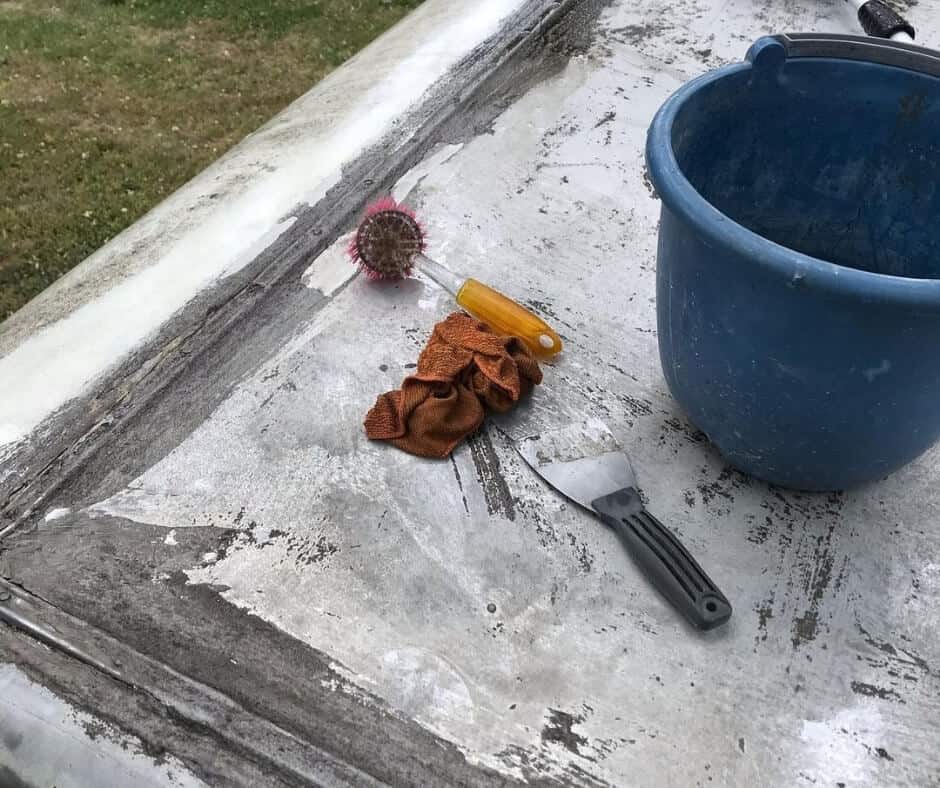
Recoat the Roof Surface
At some point during your RV’s life, you will probably need to recoat the roof. This is a protective layer that covers the roofing material almost like paint.
Over time, the coating becomes chalky and may wear off. Although this is normal, it’s a clear sign that it’s time to recoat the roof.
The coating is important because it helps to increase the waterproof and weatherproof capability of the whole roof.
Be sure to keep in mind that you might need a specific type of coating depending on the type of roof material you have.
One method of recoating is an RV liquid roof, which is an EPDM coating that you paint onto the roof of your camper.
The liquid roof costs almost $90 per gallon, which covers about 42 square feet. For our 30-foot by 8 ½ foot camper example, we’d need about six gallons to cover the roof.
You can save if you buy the material in larger quantities, such as four or five-gallon pails.
Once dry, the liquid roof barrier protects it from UV rays from the sun and also adds weatherproofing to block moisture and slow wear-and-tear from the elements.
By regularly coating your RV roof with this type of protective sealant, you can prolong the life of your RV and prevent water damage from happening.
How to Repair or Replace Your RV Roof
If you own an older RV of you’ve owned your camper for awhile, there’s a good chance that you’ll need to replace the roof at least one time during its lifespan.
If you stay on top of repairs and maintenance, and fix any leaks quickly, you can minimize or postpone the need to replace the whole roof.
However, if there are multiple areas where the roof is damaged, or there’s a single area with extensive damage that is compromising the rest of the roof, it may be time to replace it.
Tools You Will Need
When you plan to repair or replace your camper’s roof yourself, there are some tools you’ll need to get the job done as quickly and effectively as possible.
Although every job is different, some general tools you should have on hand for dealing with your RV roof include:
-
Safety glasses
-
Roller to roll out and flow the adhesive
-
Acetone or other cleaner, like a 3M Scotch Bright Pad
-
Razor knife or shears for cutting the replacement material
-
Scraper or utility blade to remove old caulking
-
Respirator (for fiberglass roofs)
-
Rubber gloves
-
Bucket for mixing adhesive/catalyst
Prepare Your RV Roof for Repair or Replacement
The first step to any RV roof job is to clean the existing roof or repair area well. In order for the adhesive or catalyst material to bond with the roof material, all traces of oil, grease, grime, oxidation and silicone sealants must be removed.
If it’s just a small repair, feel free to use a rag and a solvent to scrub the area clean.
For larger repairs and full roof resealing jobs or replacements, it might be more effective to first power-wash, then scrub where necessary until the roof is completely clean.
With EPDM roofing, you will need to cut away any residual silicone caulking and remove any surface wax with a removing agent designed for this purpose.
Once the roof is dry after cleaning, you will likely need to apply an EPDM primer.
Even if you did a fantastic job cleaning the roof, it’s likely to still be dirty or stained in some areas, so using a EPDM primer will prepare the surface for a better bond between the roof and the tape.
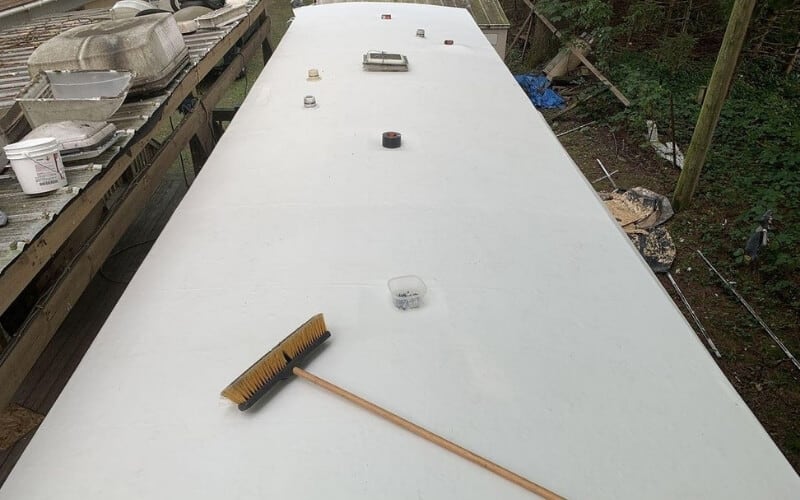
How to Repair a Punctured RV Roof
Although you might pay a professional to do a full roof replacement for your RV, there are many roof repair jobs that are easy and far cheaper if you do them yourself.
One of these is repairing a punctured or torn RV roof. To fix this kind of damage, all you really need to do is install a patch:
-
Thoroughly clean the area around the repair.
-
Remove any excess silicone.
-
Apply sealant or caulking to any recesses, and let dry.
-
Glue down any loose roof membrane, and add fasteners if needed.
-
Let it cure 24 hours.
-
Apply the patch so that there’s at least two inches of overlap on all sides of the repair area, and cover any reinforcement fasteners.
-
Seal the patch and edges around it with RV roof coating.
RV roof tape or RV roof patches are easy to apply, with adhesive on one side that sticks to your RV roof and seals up the torn or punctured area.
These patches are very durable, and provide a permanent solution to a tear or small hole.
It’s a good idea to keep some in your RV’s emergency tool kit just in case something happens while you’re out on a trip. You don’t want a punctured roof causing leaks and creating water damage!
How to Replace Your RV Or Motorhome Roof
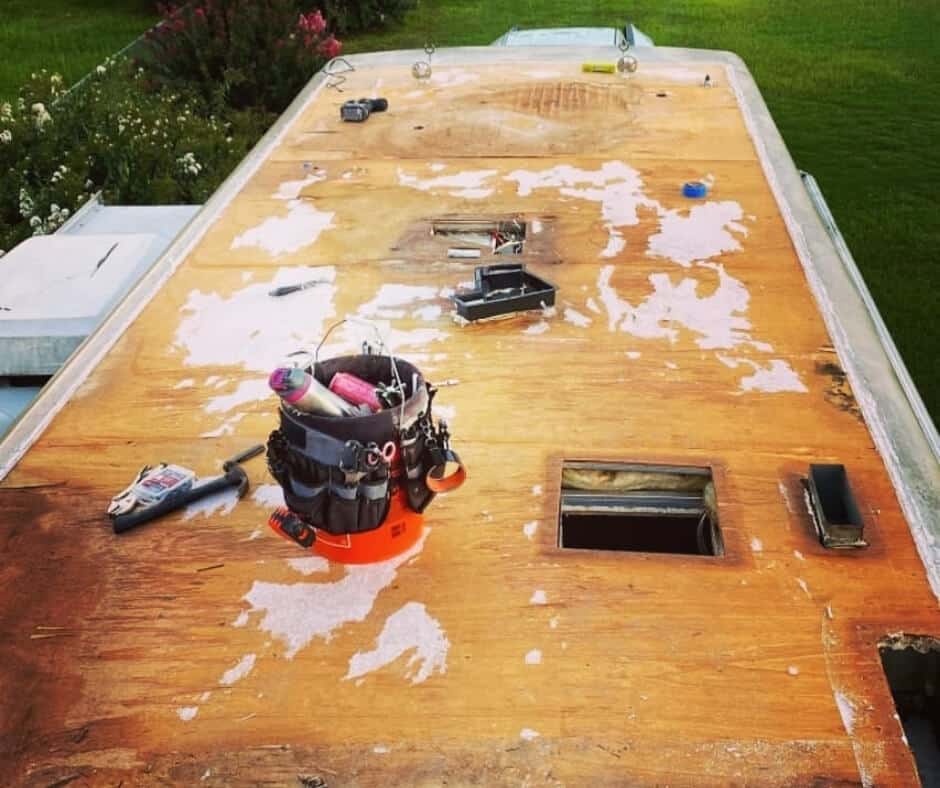
A DIY RV roof replacement is certainly possible, and will help you save lots of money since you will only need to buy the materials.
The following are all of the steps to follow when replacing your RV’s roof:
-
Remove any fixtures, such as vents, antennas, or air conditioning units. Remove the awning as well.
-
Use a high-quality stainless steel putty knife to scrape away the old sealant around the removed fixtures.
-
Remove the existing roof membrane. For RV’s rubber roofs such as TPO or EPDM, you will need to peel back the roofing material until you can see the plywood structure beneath. Aluminum roofs require you to unscrew the old panels to remove them, and you will need a dye grinder to remove the fiberglass matting that covers these types of roofs.
-
Check the plywood beneath the roof membrane for damage. If you notice areas where the wood is rotted or bowing, it has water damage and should be replaced. Clean the rest of the (undamaged) plywood with mineral spirits to treat it to prevent mold and mildew from growing.
-
Install seam tape in places where the plywood meets and along the edge of the camper’s roof where it meets the side of your camper. This will help maintain a good seal and reinforce any weak areas.
-
Rubber roofs are installed by coating layers of adhesive onto the plywood roof, then rolling on the roof replacement panels. Fiberglass roofs have similar installation, and you will paint on the adhesive catalyst resin before covering it with the fiberglass matting and gel coat. Allow the adhesive to sit for a little bit until it’s tacky, and then roll your roofing material over the top, pressing out all air bubbles as you go. Cut holes in the rubber or matting for any fixtures that are going back on the roof.
-
Rubber roofs are installed by coating layers of adhesive onto the plywood roof, then rolling on the roof replacement panels. Fiberglass roofs have similar installation, and you will paint on the adhesive catalyst resin before covering it with the fiberglass matting and gel coat. Allow the adhesive to sit for a little bit until it’s tacky, and then roll your roofing material over the top, pressing out all air bubbles as you go. Cut holes in the rubber or matting for any fixtures that are going back on the roof.
-
After your roof is replaced, the final step is to reinstall your RV’s roof fixtures and seal them with caulking to prevent any leaks in the new roof.
How to Fix a Leaky Skylight, Roof Vent, AC Unit or Hatch
Since RV’s rooftop systems such as the A/C unit or roof vent are essentially holes cut in the roof, the edges around them can develop leaks that you will need to fix to avoid water damage.
Luckily, it’s a pretty easy job:
-
Scrape away any residual silicone caulking.
-
Clean the surface of the roof around the leak with a plastic scrub pad or sandpaper, then swab with a solvent-soaked rag.
-
Seal the edges around the vent or system with sealant or sealant strips, covering all screws.
-
Position the vent flange so that it overlaps the roof surface by about two inches in either direction, and be sure to roll-in the sealant so that it bonds permanently.
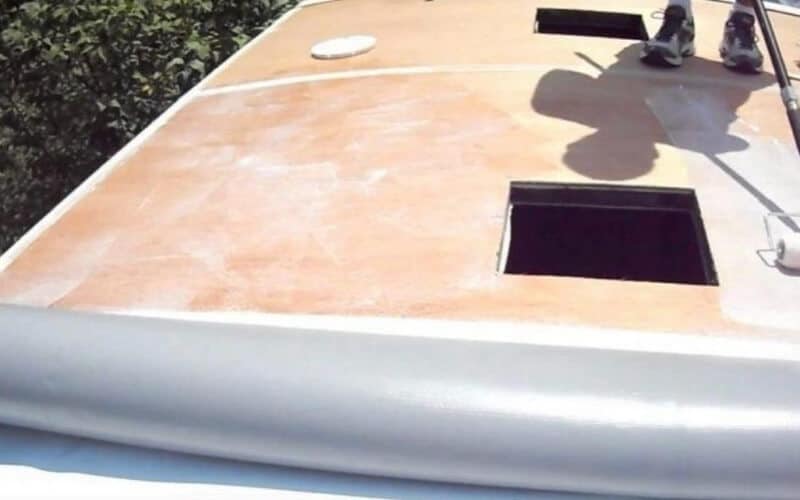
How to Seal and Coat Your RV’s Roof
A significant part of maintaining, repairing and replacing your RV’s roof involves sealing and coating the surface so that it’s more durable and weather-resistant.
What is the Best RV Roof Sealant?
The best sealant to use depends on the roof surface and the application. For EPDM, TPO and aluminum roofs, the recommended material is M-1 sealant ($7.25 per 10.1-ounce tube).
If you’re sealing around a roof vent or skylight, industry experts recommend using SB-140 butyl caulking ($5.75 per 10.3-ounce tube).
For resealing RV windows, the experts again suggest M-1 sealant, but Duralink ($6.25 per 10.1-ounce tube) is also used and has excellent adhesion to glass.
If you are sealing around irregular surfaces, the best sealant to use is WebSeal tape.
It has a unique, woven fabric backing with microsealant composition so that it bonds perfectly on flat surfaces as well as around curves, angles, bolts and pipes.
It’s also highly weather resistant, and remains flexible even in climates with temperatures as low as negative 70 degrees Fahrenheit.
How to Coat a Rubber RV Roof
If your RV’s roof is made of EPDM or TPO, you will need to re-coat it every year or so to maintain it properly and maximize its lifespan. Here are the steps for Applying Rubber Roof Coating To Your Camper:
-
Check the roof for any leaks, and repair them before coating your camper foof.
-
Deep-clean the entire roof; power-wash, then scrub stained or dirty areas with a 1:3 bleach/water mixture and a thick bristled street broom or scrubber. If the bleach doesn’t get the stains out, try TSP and water. Power wash the roof again after cleaning to rinse it.
-
Remove old RV roof coatings and all silicone excess around the roof vents, air conditioning unit, and other systems.
-
Glue down any raised areas around the roof with M-1 sealant or EternaBond DoubleStick.
-
For EPDM roofs, you should apply a thin layer of EPDM primer (and allow it to cure about 30 minutes) before applying the roof coating.
-
Open the coating can and remove any ‘skin’ on the surface. Stir the coating for four to five minutes, until it is fully combined.
-
Apply the roof coating (RoofMate HT for light foot traffic or AES-125 epoxy for more long-lasting results). Let it cure for one to three days, depending on the temperature in your area. Then, apply a second coat in the opposite direction.
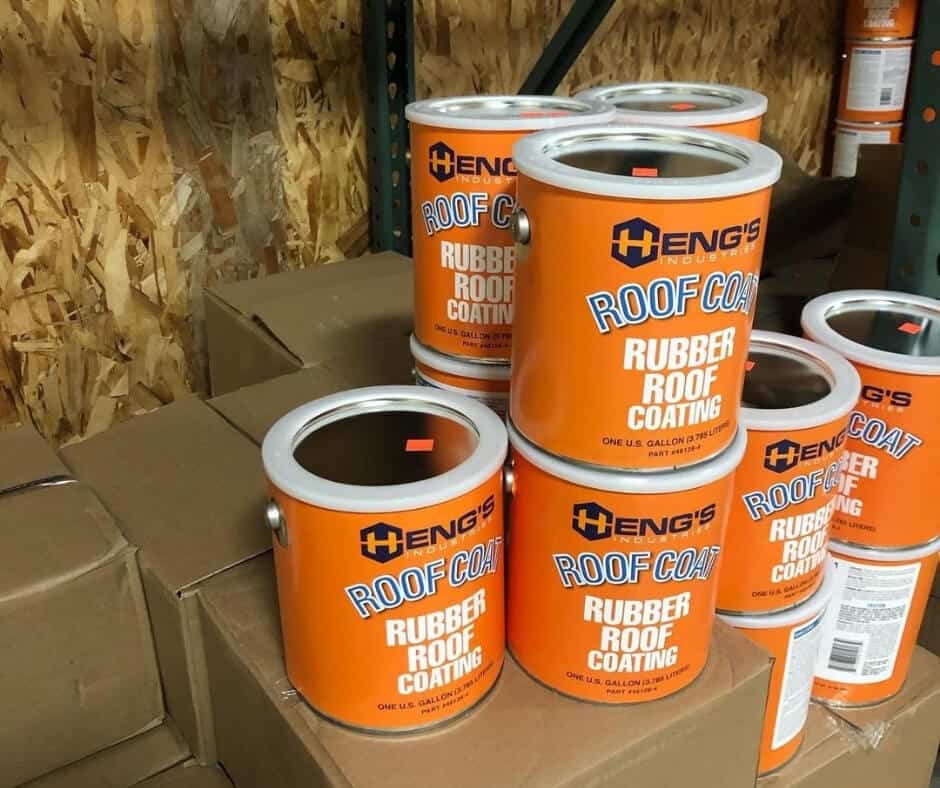
Different Types of RV Roof Coating Sealants
As mentioned throughout this article so far, there are a few different types of RV roof coating materials, and your choice will depend on what type of RV roof you have and the durability you need it to have.
How to Maintain Your RV Roof
Even if you’re repairing or replacing your RV roof yourself, the materials alone are going to cost several hundreds of dollars.
You can maximize the lifespan of your roof and minimize the frequency of re-coating by regularly cleaning it, checking frequently for leaks, repairing damage quickly, and keeping it covered.
Here are some RV roof maintenance tips as well as best practices you can follow for RV Roof Damage Prevention.
1: Clean Your RV Roof Regularly
As part of your RV maintenance schedule, you should clean the roof of your camper.
Dirt and debris can damage the sealant on your RV roof over time, and make it more prone to developing leaks and causing water damage.
Therefore, a regular washing is important to maintaining the integrity of the seals and waterproofing of the camper’s roof.
A good rule of thumb is to wash the roof when you’re deep-cleaning after each camping trip.
To wash your RV roof properly, choose your detergent based on the type of roof you have.
If your RV’s roof is aluminum or fiberglass, you can use the same mild detergent you use to wash the rest of the RV.
If your camper’s roof is TPO or EPDM, you might need a rubber-safe RV roof cleanser. Either way, rinse well after sudsing!
2: Check For Leaks
The roof-cleaning process offers the perfect time to check your RV’s roof for leaks.
As you power-wash the roof, ask your spouse or a friend to walk around below you inside the camper, checking the ceiling and walls for dampness or drips.
As you wash or rinse the roof, look for cracks in the roof seal and feel for any soft areas that may be a sign of water damage or rot. Fix leaks quickly and as you discover them to minimize damage.
3: Repair RV Roof Damage ASAP
As soon as you notice leaks or other damage in the roof or its fixtures, repair them.
It’s better to spend a few hundred dollars on a repair job now, than to have to pay nearly $10,000 to replace the whole roof.
Additionally, damage that’s allowed to sit unaddressed can get worse, and lead to more issues or more extensive and expensive repairs.
The same goes for your rooftop systems, like the air conditioning unit. If it stops working, moisture can build up in the system and may strain the seal between the unit and the roof, or cause mold and mildew to develop.
4: Investing In A RV Roof Cover for Durability

In addition to all of the maintenance you should do to maximize the lifetime of your RV’s roof, you may want to consider a cover for your camper or just for the roof.
It’s optimal to store your RV indoors, but this is often very expensive and might be out of budget for most RV owners.
An alternative is a waterproof and UV-resistant RV cover or an RV roof cover.
These come in a wide range of measurements, so the trick is to get one that is specifically designed to fit your camper or its roof.
However, even RV covers have their disadvantages. A good quality RV cover will allow moisture to evaporate, but it also prevents airflow from circulating around your RV underneath it, so mildew can grow.
So, it’s best to give your RV a break and only cover it during storage season.
Note: Tarps are even worse than RV covers at allowing mildew and mold to grow in a short period of time, so only use these as a short-term solution.
Conclusion
Although a professional RV roof replacement job will likely cost as much as $325 per linear foot, you can significantly reduce the cost if you replace your RV roof yourself.
I hope this article has provided all of the resources you need to know how much an RV roof replacement might cost, the materials involved, and how to repair or replace your camper’s roof on your own.




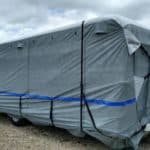



3 Comments
Jared
3 years agoHi Aaron,
Thanks for the great article! Do you know how we can tell what material we have? EPDM vs TPO? We had a raccoon crawl up under our RV cover during winter and scratch a few area of the EPDM/TPO down to the plywood.
I’m wondering if it’s best to patch these areas with a primer and patch or a roll on type product. Do you have a preference or recommendation for a 4 by 12-18” inch area that was scratched? Thanks!
Aaron Richardson
3 years agoI wrote a comprehensive guide on this exact same topic https://www.rvingknowhow.com/rv-roof-replacement-and-repair-guide/
Amy A
2 years agoOne of these is repairing a punctured or torn RV roof. To fix this kind of damage, all you really need to do is install a patch:
Thoroughly clean the area around the repair.
Remove any excess silicone.
Apply sealant or caulking to any recesses, and let dry.
Glue down any loose roof membrane, and add fasteners if needed.
Let it cure 24 hours.
Apply the patch so that there’s at least two inches of overlap on all sides of the repair area, and cover any reinforcement fasteners.
Seal the patch and edges around it with RV roof coating.
RV roof tape or RV roof patches are easy to apply, with adhesive on one side that sticks to your RV roof and seals up the torn or punctured area.
These patches are very durable, and provide a permanent solution to a tear or small hole.